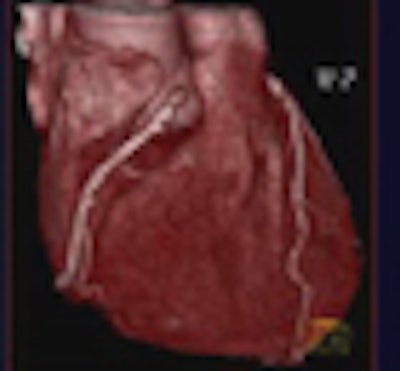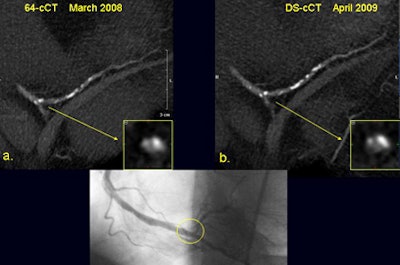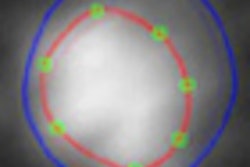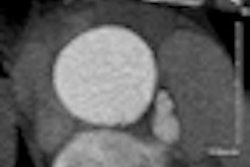
Coronary CT angiography performed on dual-source CT (DSCT) confers a slight advantage in image quality with slightly fewer nondiagnostic vessel segments compared to 64-detector-row CT. Calcification remains a challenge with both types of scanners, but it's slightly less problematic with dual-source systems, say researchers from the University of Rome.
"Coronary CT angiography is a valid noninvasive tool for the characterization of coronary atherosclerosis; however, motion and blooming artifacts are seen as essential challenges to image quality and accurate detection of vessel stenosis," said Dr. Nicola Galea.
The recent introduction of DSCT, delivering temporal resolution of 83 msec, appears promising for the further improvement of image quality at coronary CT angiography (CTA), he said.
Galea, along with Dr. Adriano Ascarelli and colleagues from the University of Rome "La Sapienza," aimed to prospectively and subjectively compare the two modalities for image quality to determine whether plaque composition and motion-related artifacts influence the diagnostic performance of 64-slice coronary CTA and dual-source CTA. Galea presented the study at the 2009 RSNA meeting in Chicago.
In all, they scanned 129 patients -- 124 on a 64-detector-row machine and 35 on a dual-source CT system. A subgroup of 23 patients was scanned with both modalities due to stent patency follow-up exams, he said.
 |
| Coronary CTA images were acquired with 64-slice single-source (left) and dual-source CT (right) technique. In a 62-year-old man, the presence of calcifications makes the degree of stenosis difficult to evaluate. Better discrimination of both calcifications and coronary lumen obtained with DSCT clearly defines irregularities. Invasive angiography study (bottom image) confirms moderate stenosis at this level. All images courtesy of Dr. Nicola Galea. |
Electrocardiographic pulsing and retrospective gating were used in all cases. Prior to scanning, all patients received 70 mL of 400 mgI/mL iodinated contrast material (Bracco, Milan, Italy) injected at 5 mL/sec with the use of beta-blockers.
Two expert readers assessed image quality for both diagnostic and nondiagnostic exams. The patients underwent invasive coronary angiography within three days following CT. All vessel segments assessed as nondiagnostic were considered false positive or negative with respect to the coronary angiography results, Galea explained.
Two patients were excluded for nondiagnostic image quality, and nearly 24% of vessel segments were excluded due to their small diameter. All coronary segments were analyzed by two radiologists for technical adequacy (i.e., the presence of motion artifacts), the presence and grade of coronary stenosis, and the composition of detected plaques.
"The comparison between two groups showed an improvement in image quality and a decrease in number of nondiagnostic segments in the dual-source group," Galea said.
According to the results, visualization of the entire coronary tree was successful in all 35 patients who underwent dual-source CTA, and in 92 of 94 patients who underwent 64-detector-row CTA. However, image quality was significantly higher at dual-source CTA (Wilcoxon test, p = 0.008).
 |
| Electrocardiogram-gated 64-slice CT (a-c) and dual-source CT (b-d) in a patient with an extensive calcified plaque of the anterior descending artery (a-b) and multiple atherosclerotic irregularities of the right coronary artery (c-d). DSCT, with its sharper delineation of heavily calcified plaque borders, allows a substantial reduction of blooming artifacts, thereby limiting overestimation of plaque burden. |
The sensitivity and specificity for detecting stenoses greater than 70% were 76% and 88%, respectively, for 64-detector-row CTA and 84% and 91%, respectively, for dual-source CTA, the authors noted in an accompanying abstract.
Accuracy for detecting stenoses greater than 70%
|
The accuracy of both techniques largely depended on plaque composition and decreased progressively on both scanners as plaque composition became denser. Still, the accuracy of 64-detector-row CTA was significantly lower than that of dual-source CT for all types of plaques, they reported.
"Results show better overall [90%] accuracy with dual-source CT compared to 64-detector-row [87%]," Galea said. "Among DSCT advantages, we have better diagnostic accuracy for all kinds of lesions, in particular calcified lesions," he said, noting that only 63% of such lesions were included in the comparison with invasive angiography.
Recent studies demonstrate that calcified segments "can be overestimated three to four times by CT, and this overestimation can be reduced by DSCT," Galea said. "DSCT improves diagnostic accuracy; however, calcification is the main drawback," he said. "By affecting image quality, it continues to be the fundamental challenge to diagnostic accuracy."
By Eric Barnes
AuntMinnie.com staff writer
January 8, 2010
Related Reading
CT treads MRI turf by diagnosing myocardial edema, December 17, 2009
Coronary CTA edges CMR in a tight race, December 1, 2009
DECT cuts tests as a one-stop myocardial, coronary artery exam, August 10, 2009
Cardiac CT matches SPECT for perfusion analysis, September 17, 2009
Contrast-enhanced CT finds myocardial infarction, June 10, 2004
Copyright © 2010 AuntMinnie.com



















